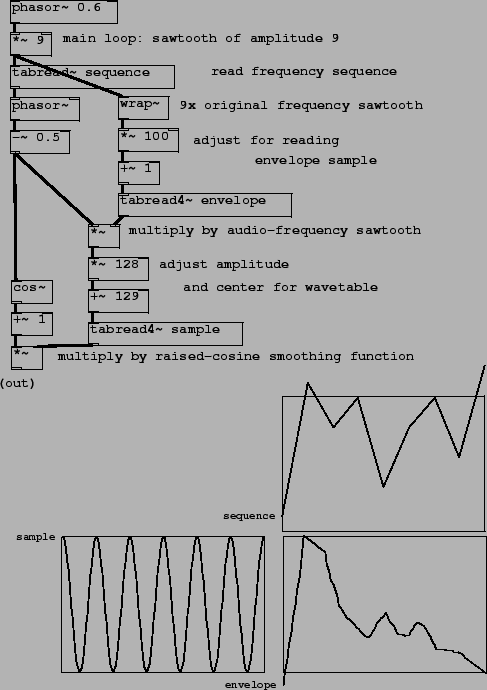 |
Patch C08.analog.sequencer.pd (figure 3.15) realizes the analog sequencer and envelope generation described in section 3.7. The ``sequence" table, with nine elements, holds a sequence of frequencies. The phasor~ object at top cycles through the sequence table at 0.6 Hz. Non-interpolating table lookup (tabread~ instead of tabread4~) is used to read the frequencies in discrete steps. (Such situations, in which we prefer non-interpolating table lookup, are rare.)
The
![]() object converts the amplitude-9 sawtooth to a
unit-amplitude one as described earlier in Figure 3.8, which is
then used to obtain an envelope function from a second wavetable. This is
used to control grain size in a looping sampler
(from section 2.6.4). Here the ``sample" consists of six
periods of a sinusoid. The grains are smoothed by multiplying by a raised
cosine function (
object converts the amplitude-9 sawtooth to a
unit-amplitude one as described earlier in Figure 3.8, which is
then used to obtain an envelope function from a second wavetable. This is
used to control grain size in a looping sampler
(from section 2.6.4). Here the ``sample" consists of six
periods of a sinusoid. The grains are smoothed by multiplying by a raised
cosine function (
![]() and
and
![]() 1). (This
multiplication can cause audible artifacts which will be discussed in
chapter 5.)
1). (This
multiplication can cause audible artifacts which will be discussed in
chapter 5.)
Patch C09.sample.hold.pd (not pictured here) shows a sample-and-hold unit, another useful device for doing control tasks in the audio signal domain.